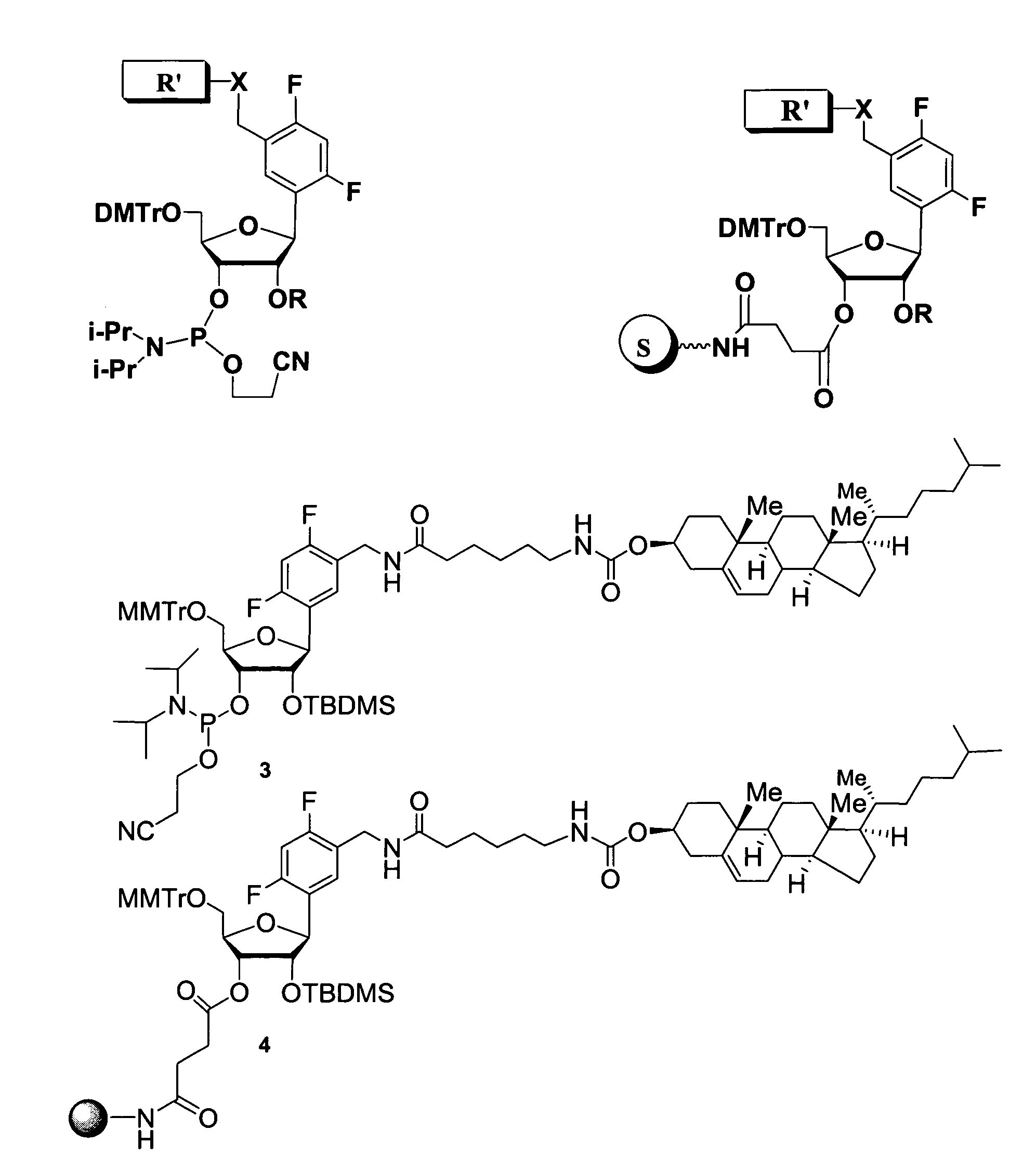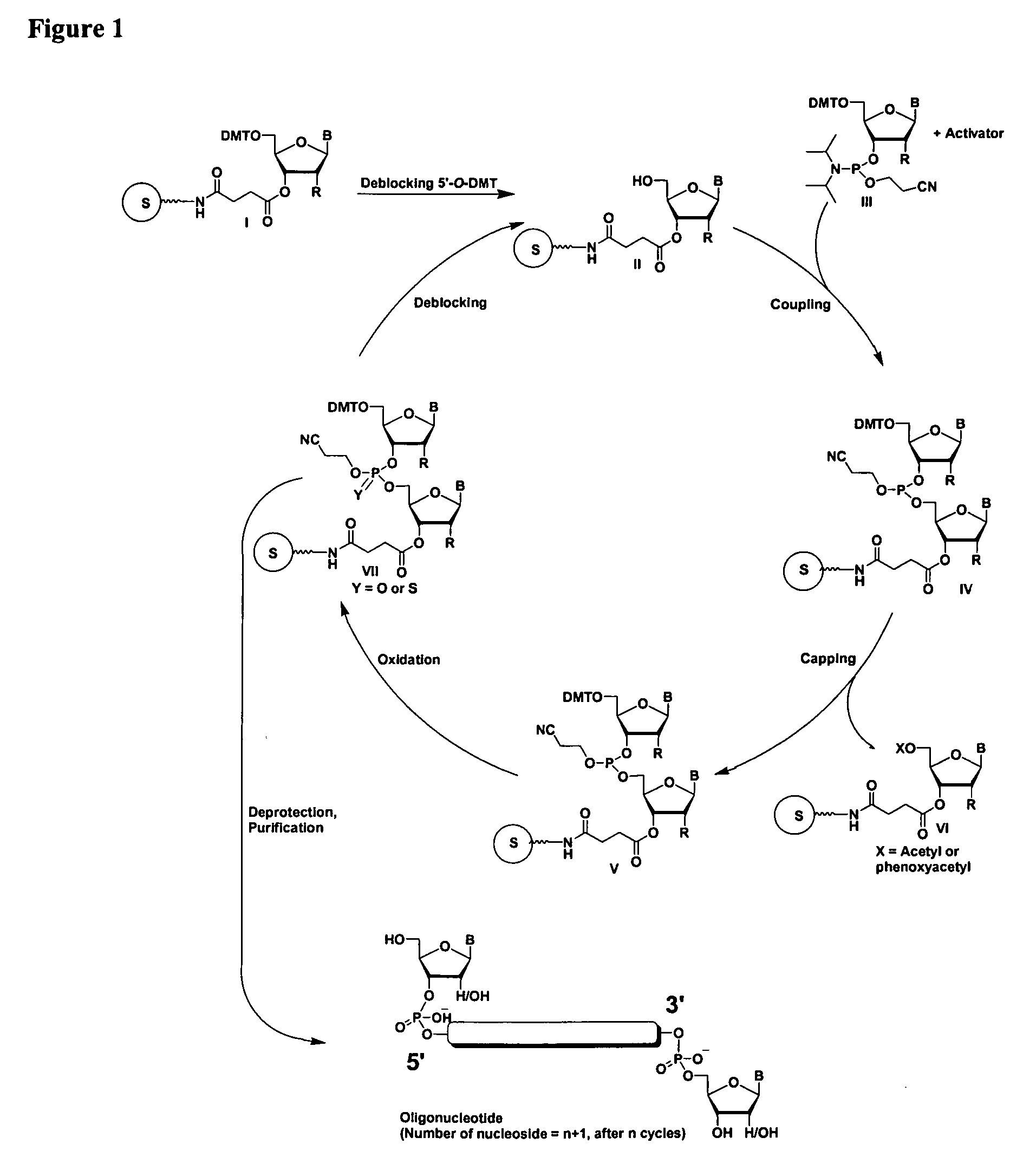Oligonucleotides comprising a ligand tethered to a modified or non-natural nucleobase
a technology of oligonucleotides and ligands, which is applied in the field ofoligonucleotides comprising a ligand tethered to a modified or non-natural nucleobase, can solve the problems of poor serum solubility of oligonucleotide sequences, poor cellular distribution and uptake, and rapid excretion, etc., and achieves the effect of reducing the number of oligonucleo
- Summary
- Abstract
- Description
- Claims
- Application Information
AI Technical Summary
Benefits of technology
Problems solved by technology
Method used
Image
Examples
example 1
Part I: Synthesis of 5′-O-(4,4′-dimethoxitrityl)-2′-O-(tert-butyldimethylsilyl)-1′-(2,4-difluorotoluene)-D-riboside-3′-O-cyanoethyl-N,N-diisopropylphosphoramidate and 5′-O-(4,4′-Dimethoxitrityl)-3′-O-(tert-butyldimethylsilyl)-1′-(2,4-difluorotoluene)-D-riboside-2′-O-cyanoethyl-N,N-diisopropylphosphoramidate
General Procedures
[0848]TLC was conducted on glass plates precoated with a 0.25-mm layer of Silica Gel 60 F-254 (Merck analysis). The compounds were visualized either by exposure to UV light or by spraying with 5% H2SO4, and 0.2% p-anisaldehyde in a solution of ethanol and heating or both. Solutions were concentrated under reduced pressure at 1H-NMR spectra were recorded at 30° C. with 400 MHz spectrometer. The values of δ (ppm) are given relative to the signal (δ 0) for internal Me4Si for solutions in CDCl3, CD3OD, and DMSO-d6. 13C-NMR spectra were recorded at 303.0 K with a 400.0 MHz or 500 MHz spectrometer using CDCl3 (77.0 ppm), CD3OD (49.15 ppm), and DMSO-d6 (39.5 ppm) as ref...
example 2
[0867]2,4-Difluoro-5-Bromo-(α-bromomethyl)benzene (12). To a solution of 2,4-difluoro-5-bromotoluene 5 (57 g, 0.28 mol), NBS (51.5 g, 0.29 mol) in dry CCl4 (277 mL) was added benzyol peroxide (1.99 g, 8.2 mmol) and stirred at 80° C. for 6 h under an argon atmosphere. The solids were filtered off and the filtrate was concentrated into a crude residue which was applied to a column of silica gel eluted with hexanes to give a pure compound 12 (46.98 g, 60%) as a clean oil. 1H-NMR (CDCl3, 400 MHz): δ 7.60 (t, 1H, J=7.6 Hz, ArH), 6.90 (t, 1H, J=8.6 Hz, ArH), 4.45 (s, 2H, CH2Br). 19F-NMR (CDCl3, 399.8 MHz): δ−126.84 (q, 1F), −138.45 (q, 1F). 13C-NMR (CDCl3, 100 MHz): δ 160.79 (dd, J=10.6 Hz, J=59.5 Hz), 158.23 (dd, J=10.7 Hz, J=62.8 Hz), 135.03 (dd), 123.13 (dd, J=3.9 Hz, J=15.7 Hz), 105.50 (t, J=26 Hz), 104.11 (dd, J=4.6 Hz, J=21.4 Hz), 53.54 (CH2Br). Anal. of C7H4F2Br2: 283.6. ESIMS (m / z). Found: 283.5 [M]+.
example 3
[0868]5-Bromo-(α-O-benzyl)-2,4-difluorobenzyl alcohol (13). To a solution of benzyl alcohol (504 mg, 4.67 mmol) in dry THF (3 mL) was added sodium hydride (467 mg, 11.68 mmol, 60% dispersion in mineral oil) and stirred at room temperature under an argon atmosphere for 30-40 min. 2,4-Difluoro-5-(α-bromomethyl)benzene 12 (1.46 g, 5.14 mmol) in dry THF (1 mL) was then added to the above reaction mixture and stirred at the same temperature under an argon atmosphere for 2-3 h. The reaction mixture was quenched with cold water and concentrated to removal of THF and extracted with dichloromethane (3×50 mL). The organic phase was washed with sodium bicarbonate, brine, dried (Na2SO4), and concentrated into a crude residue which was applied to a column of silica gel eluted with hexane-ethyl acetate (2:1) to give a pure compound 13 (976 mg, 67%) as a clear oil. 1H-NMR (CDCl3, 400 MHz): δ 7.66 (t, 1H, J=7.6 Hz, ArH), 7.40-7.29 (m, 5H, ArH), 6.88 (t, 1H, J=8.8 Hz, ArH), 4.60 (s, 2H, CH2O), 4.54 ...
PUM
| Property | Measurement | Unit |
|---|---|---|
| diameter | aaaaa | aaaaa |
| diameter | aaaaa | aaaaa |
| diameter | aaaaa | aaaaa |
Abstract
Description
Claims
Application Information
 Login to View More
Login to View More - R&D
- Intellectual Property
- Life Sciences
- Materials
- Tech Scout
- Unparalleled Data Quality
- Higher Quality Content
- 60% Fewer Hallucinations
Browse by: Latest US Patents, China's latest patents, Technical Efficacy Thesaurus, Application Domain, Technology Topic, Popular Technical Reports.
© 2025 PatSnap. All rights reserved.Legal|Privacy policy|Modern Slavery Act Transparency Statement|Sitemap|About US| Contact US: help@patsnap.com



